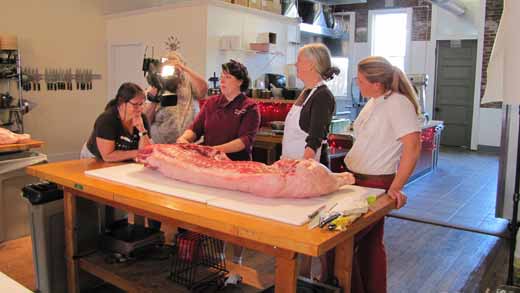Part 2. Food writer Kathleen Bauer describes Roger’s humane slaughter and afterwards when the carcass is delivered to Melinda Casady’s butchery studio (Portland’s Culinary Workshop). Bauer describes her uneasiness butchering the pig she came to know as Roger.
Bauer is given expert instructions how to carve the carcass into appropriate cuts of meat. One obvious lesson from her farm to plate project, in helping to raise the pastured pig, she developed feelings for Roger which only increased her natural resolve to not waste any usable portions of the animal.

As Kathleen explains in the video, something she didn’t expect would happen in her life: she learned how to butcher a pig.
To watch the full Pig to Plate series:
- Pastured Pig to Farm: The Farm
- Pastured Pig to Plate: Butchering the Pig
- Pastured Pig to Plate: The BBQ Pork Roast Celebration
Below is the video transcript:
I got there a little before Richard, who did the kill, and Clare led them over with the eggs, and basically as she was feeding Don the eggs, Roger came over to see what Richard was up to, and he just, like, shot him right behind the ear. Just right back here. And it goes right to their brain, and he was brain dead instantly. He just flopped to the ground. I knew it was Roger, and I was kind of watching, and I didn’t really feel shocked. I felt a little separated from what was going on, but I wasn’t, like, you know. Richard is very calm and very professional about what he does. It’s obvious that he knows what he’s doing, and he does it in a very kind and considerate way, in a very humane way.
Hello. Oh, OK. She’s here. She’s here. Yeah. Why don’t you just park here, and we can bring it in this way. Oh, they’re together.
Yeah, they’re –
Oh, my goodness. I want to butcher the pig because I wanted to be part of the whole process.
You can also carry him in just like this. I don’t have any problem –Oh, as like a whole carcass –
Yeah –
Yeah.
OK. How strong are you, Kathleen –
I don’t know. We’ll see.
You can each carry fifty pounds, right.
Yeah.
Yup.
Perfect.I have a neighbor and a friend who has a cooking school and teaches whole animal butchery as part of their curriculum. It was a really easy place to do it, and I knew we wouldn’t just be going in and start whacking on a carcass. You know, we would be able to get some instruction and learn how to do it right and have some choices about the way it was cut it and the pieces we would get out that, and that was important to me because I didn’t want to waste anything.
This is your aerobic exercise for the morning.
I want to have as many pieces as I could because I wanted to make sausage, I wanted to use the bones for soup and stock.
Yeah. That can go in the Roger bucket.
Using the fat for cooking later. Roger. Roger. Piece number one.
We’ll probably want to take off some of these organ bits. There’s just little bit of organ bits left over. We put that in the compost and –
OK –
So just that, just cut with a knife –
OK –You’re just going to cut the gel right off, and then you’re going to use the, you can score it with a knife if you want to, but the majority of that, you’re going to go through with a hacksaw.
Why don’t you come back when I’m starting on, once I get this, once I’m starting on that just to make sure I know where I’m doing it. Do I basically just follow with a hacksaw follow this line –
Well, now it’s not , it’s not. Well, you’re not following the line of the shoulder blade as much –
OK –
As you’re just cutting it straight –
Straight across. OK. Alright. I can do that. It’s nice to have a sharp knife. So, yeah, this is a little weird. The whole animal butchery is kind of, it’s a little bit strange. I mean. Just saying, you know, I knew this pig, this is Roger, I’m cutting him up, it just feels a little odd. I mean, not that generations of 4Hers haven’t gone through this, but if you’ve never done it, and you’re in your 50’s, it’s a little weird.As a food writer, I think I need to know about the process of what it takes to make food, and from a very basic level, and I think it helps me to explain it to other people. So where do I. To do it. I mean, it I haven’t done this, how can I explain butchery or the importance of it or what it takes to get food to your table if I haven’t actually done it. I guess I’m the kind of writer that needs to experience things.
Voila, you have a ham.To make it real to people. It’s, I can’t just read a bunch of stuff on the Internet and write about it. I’m just saying. Amazing, huh. It is amazing. As part of the project, as part of experiencing from raising the pig through the butchering and through the cooking, I wanted to celebrate Roger’s life, in essence, and what he’s given us.
Most of the videos featured on Cooking Up a Story were produced, filmed, and edited by Rebecca Gerendasy. Fred Gerendasy contributed as a writer to many of the posts and occasionally as the interviewer. Visit Rebecca Gerendasy Clay – Art and Fred Gerendasy Photography to see their current work.

